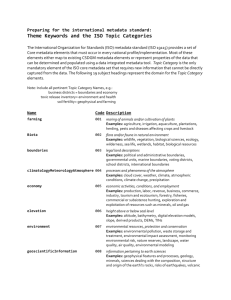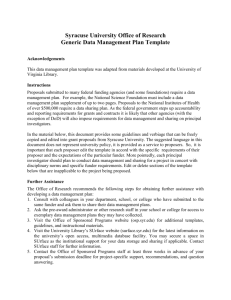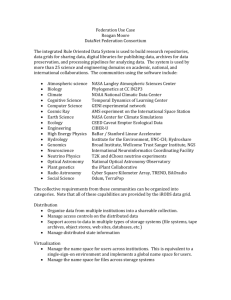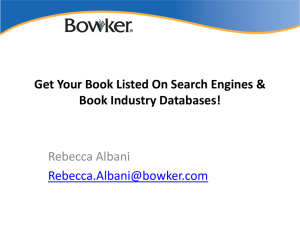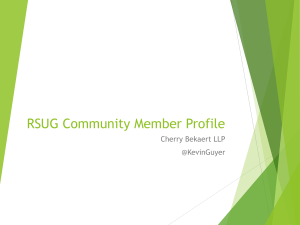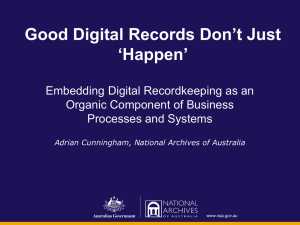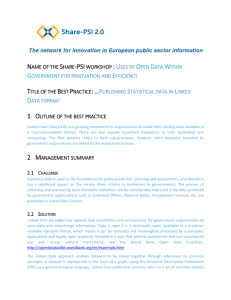A Vision of Rigorous & Invisible Records Management
advertisement
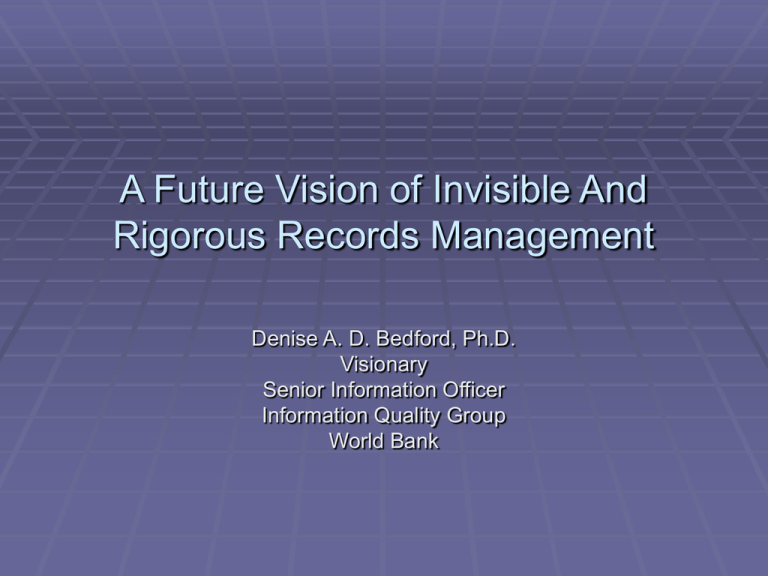
A Future Vision of Invisible And Rigorous Records Management Denise A. D. Bedford, Ph.D. Visionary Senior Information Officer Information Quality Group World Bank Disclaimer Before I begin today, let me issue a general disclaimer -the vision I’m describing is one that I have been promoting but it is not one that has yet been adopted. I think this approach is practical when some basic components exist I will leave it to your discretion, though, to decide whether I am talking ‘everyday science’ or ‘science fiction’ Remember, though, that science fiction has given us some of our best visions for the future Presentation Overview Problem Statement: Records management is essential. The RM challenge is increasing, no one likes to do it and with the new requirements we can’t rely on individuals to do the right thing all the time. Vision: An information context in which records management occurs everyday in the work environment, without people having to think about it, and it satisfies the standards of records managers Realizing the Vision: What you need to have in place and a progressive approach to realizing the vision Statement of the Problem Tim has already described the challenge very well… Amount of information generated by institutions is increasing Records requirements are also growing Records management services are struggling to keep up with the amount of information and the requirements The traditional approach provides us with a very strong base of practice for paper-based records • Question is whether the human-centered implementation approach will be practical for the volume of information in the future and in particular for electronic records Statement of the Problem Information systems make it easier for people to create records in a fragmented and scattered way – people don’t know records management and we will never train everyone to do it right or even to do it consistently A business process may now span three or four information systems – leaving records along the way, in different records management contexts The same people are now participating in all phases of the information life cycle – they have more of an impact on our total information picture Records managers must now monitor multiple systems and design schedules to suit different information types and context – structured data, semi-structured/fragmented data, and unstructured data Big Picture RM Model From my perspective, it seems like we will always be chasing the records challenge and never quite catching up to the demand Managing records in my humble opinion means full life cycle management not just the end stage of ‘archiving’ While some records may be born on paper these days, and while paper records will always be with us, many records today are born digital. I don’t need to explain to this group of experts what the full life cycle process is for records, nor should I attempt to discuss the considerations involved in declaring a digital object a record and preserving it My contribution today will be to share a vision of an approach to id Statement of the Problem What kinds of problems are we trying to solve? Potential loss of Institutional records Unintended access by non-privileged users Unintended publication of information before disclosure due dates Electronic information systems which are overwhelmed with redundancies and convenience copies Labor intensive RM activities which are challenged to keep up with the demand How do we avoid these problems? Vision Staff member needs to complete a required document as part of her/his every responsibilities. They access the template library, find the right structure and write their report. Once the person has finished writing the report, he/she saves it. Metadata is automatically generated and embedded in the document structure when it is saved by the user. The template that was used to create the document also has sufficient information to make a ‘best guess’ as to where it should be stored, and what other information and records management actions are appropriate. Information and records management functions occur once the document is completed because business rules would be built into the template context. Vision From the business rules, we can make a best guess at whether it is a record or a convenience copy, which record schedule should be assigned to it, which records management actions should be taken, and when they should be taken. The template also provides some structure for the document and stores it as semi-structured information Ideally, each part of the document may carry the metadata of the ‘whole’ wherever it goes if and when it is fragmented or reused Realizing the Vision Minimum Components of the solution Fully-elaborated and institutionally-comprehensive RRDS Organizational Unit Authority File Series Definition Authority File Item-Level Retention & Dispositioning File Rule-Based Retention & Dispositioning Expert System Enterprise-Level Core Metadata, including archival metadata Metadata Repository with links back to source system metadata records Management reporting tools Managed content systems Archives Management System Robust and actionable definition of what constitutes a record copy…. What would the system do? Another caution – such a system is envisioned to assist records experts in managing records but not to do records management instead of records managers The intent is to at least get some control over what are likely to be records into the content when it is created Essentially moving some of the records management work upstream into a document or content management life cycle stage The most proactive aspect of the envisioned system would be a centralized reporting capability running off the metadata repository that would alert content owners and system administrators that a records management action was due within a specified period of time What would the system do? Such a basic reporting system could help records managers … Prevent loss of Institutional records because content marked as a record copy could be ‘deletion disabled’ and identified earlier in the cycle Manage information systems which already are overwhelmed with redundancies and convenience copies by retaining only record copies Labor intensive RM activities which only react to records management requests could not see records issues earlier in the process and actually have a change to do more proactive records management Unintended access by non-privileged users because security class and record status could be tagged when the document is born digital rather than when it is appraised at a later date Unintended publication of information before disclosure due dates because metadata could be used to prevent publication outside of established policies and rules Realizing the Vision Realizing the vision, though, presumes that you have the components available in a foundation This is not a silver bullet vision Each of the components is a challenge to achieve I think it is possible to realize the vision – incrementally and cautiously Using templates Managing content Generating metadata Elaborating the RRDS at the institution level Writing the business rules It may be 5 or 10 years down the road, but it can happen

